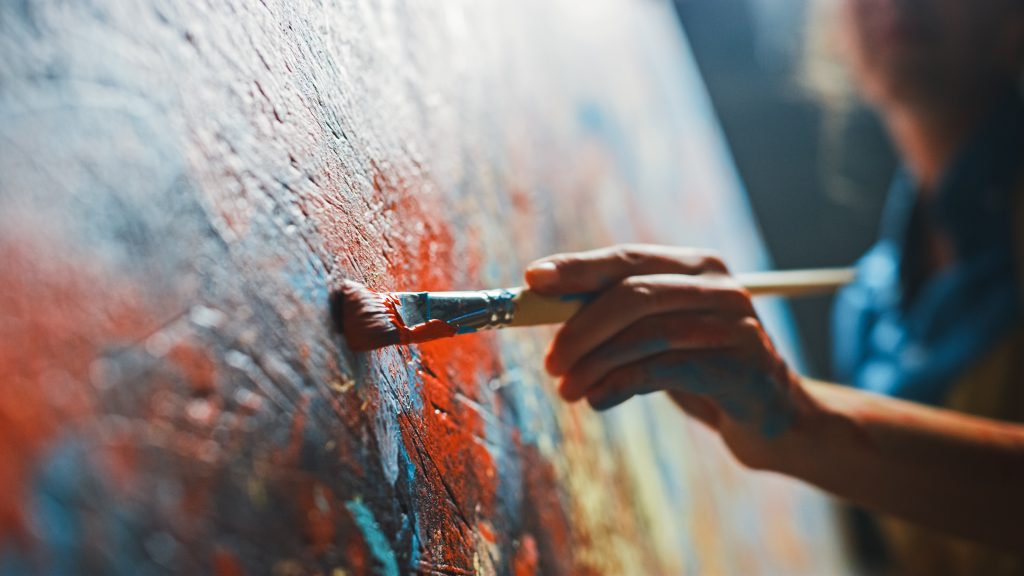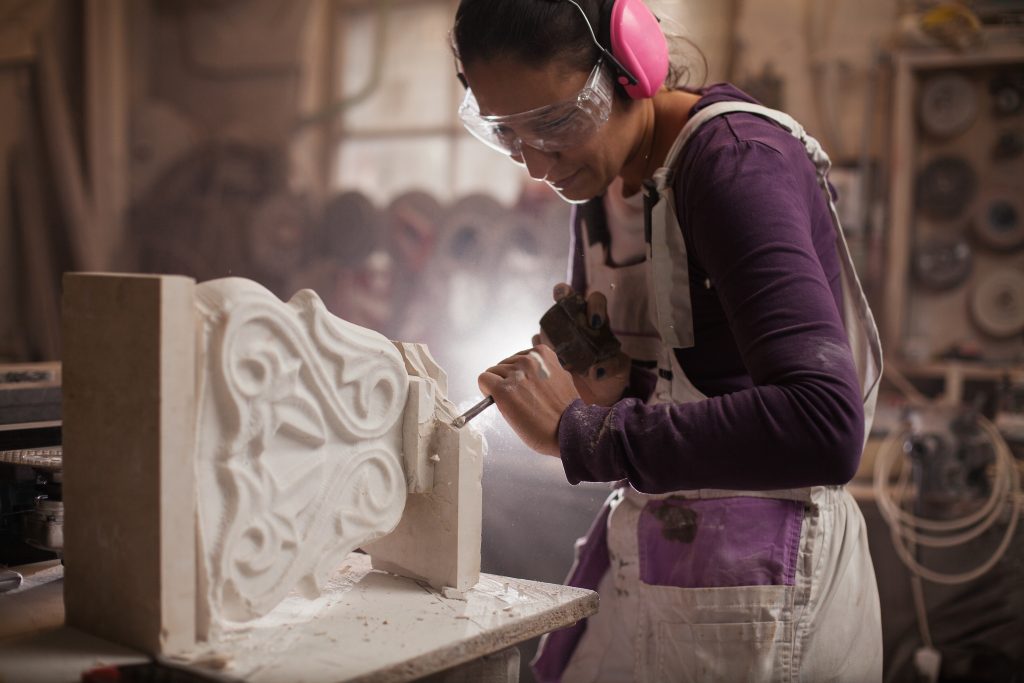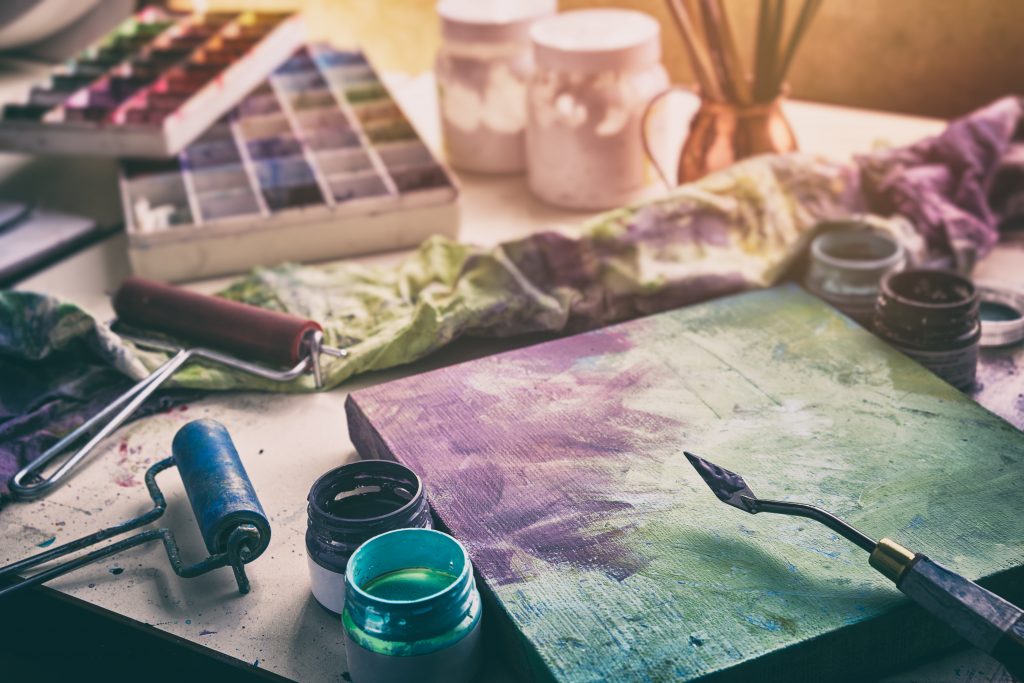 While you may rely on your raw talent as an artist, graduates of artist programs – those who’ve earned an artist degree – often find success earlier than those without artist schooling. But what are the best degrees for artists? What kind of artist schooling will meet your needs? Answers to these questions and more are detailed in our article on what’s the best degree path to becoming an artist. Below you will find information on the proper education for artists, the best artist majors, the earnings potential and job outlook for this profession, and more.
While you may rely on your raw talent as an artist, graduates of artist programs – those who’ve earned an artist degree – often find success earlier than those without artist schooling. But what are the best degrees for artists? What kind of artist schooling will meet your needs? Answers to these questions and more are detailed in our article on what’s the best degree path to becoming an artist. Below you will find information on the proper education for artists, the best artist majors, the earnings potential and job outlook for this profession, and more.
Education for Artists
Graduates of artist degree programs may find work in art and design, including animation, fashion, film, graphic design, printmaking, and more. Most fine artists pursue an artist degree, such as a bachelor’s in fine arts (BFA). A BFA is awarded in the more creative and artistic disciplines. Artist majors include art, literature, music, and more. Depending on the program, the degree can take up to four years to complete. Some BFA programs may take less or more time to complete because of the required studio work. After completing the degree, graduates are prepared to work as artists or enroll in a postgraduate degree program, such as the MFA. An MFA or Master of Fine Arts degree signifies that an artist is a professional in their field. MFA programs require rigorous courses in a specific area of art. They vary in length, with accelerated programs lasting one year and other programs lasting anywhere from two to three years. Courses in MFA studio art programs focus on a wide variety of topics. These courses may include:- Graduate art history
- MFA graduate group critique
- Qualifying review
- Studio art
Beyond Artist Schooling: Additional Training Required for an Artist
Most artists, particularly fine artists, improve their craft and skill through practice. Repetition hones an artist’s ability. In addition to artist schooling, fine artists may learn on the job as they work alongside more experienced artists. Some artists take classes, both for credit and not for credit, at community colleges and community art centers, while others attend workshops and training offered at galleries and museums.
Other Important Qualities Needed for Artists
Artists have unique skills that are used when they create. These skills may be taught in the classroom, as artists earn a degree, or they may be developed over time. But, some skills and qualities of successful artists have nothing to do with artistic ability. There are other important qualities that lead to success.- Business skills: An artist who wants to make a living creating art must have strong business skills. Artists must study the market for their artwork to better understand what prospective customers want. Successful fine artists and craft artists often sell their work online, so developing an online brand and presence is helpful.
- Customer-service skills: For artists who sell their work themselves, strong customer-service skills are important. Artists should be good at handling customer-service issues, communicating with prospective buyers, and networking with gallery and museum directors and curators.
- Interpersonal skills: Successful artists know how to comfortably interact with the general public. They work closely with clients, customers, gallery owners, and museum curators. For artists who instruct, having good interpersonal skills is essential to the role.
- Strong dexterity: Artists of all kinds have good manual dexterity. The daily work requires manipulating tools and using materials that require strong and flexible hands.
Career Advancement for Artists
With an artist degree and experience, one can advance in the profession. Fine artists advance professionally when they establish a strong reputation. To establish a reputation in the art world, an artist’s work must be circulated and noticed. They must hone their skill, develop new ideas, and become comfortable with their style. Over time, an artist’s work evolves.Earnings for Artists
Artist pay varies by the type of art they produce, as well as the industry and geographic location that they work in. According to the Bureau of Labor Statistics (BLS), the median annual wage for craft and fine artists is $49,120. However, the lowest 10% of artists earn less than $22,100 and the highest 10% earn over $112,930. While earnings for artists varies widely, the average for this profession is higher than the average of $41,950 for all occupations. BLS reports three types of artists and their corresponding median annual wages. According to BLS, artist type impacts earnings. The top three types of artists and their wages are as follows:- Artists and related workers: $65,800
- Fine artists, including illustrators, painters, and sculptors: $52,340
- Craft artists: $35,180
- Federal government: $93,630
- Motion picture and sound recording: $76,070
- Personal care services: $39,600
- Independent artists: $37,300
- California
- Connecticut
- New Jersey
- Massachusetts
- Minnesota
- Bridgeport, Stamford, Norwalk (Connecticut): $90,470
- Los Angeles, Long Beach, Anaheim (California): $88,260
- Detroit, Warren, Dearborn (Michigan): $86,650
- San Francisco, Oakland, Hayward (California): $85,660
- Baltimore, Columbia, Towson (Maryland): $79,710

Job Outlook for Artists
Favorable growth in the artist profession is drawing more people to pursue a career in the arts. According to the Bureau of Labor Statistics (BLS), the overall employment of craft and fine artists is projected to grow 14 percent through 2030. This means that over the next decade or so, a substantial number of new jobs will be available for artists. When compared to the average projected growth rate of eight percent for all occupations, employment growth for artists is highly favorable. However, since the profession is small, there should only be about 5,900 openings for artists each year over the next decade. Growth should result from the need to replace artists who exit the labor force through retirement or transfer to a different profession. In addition to the need to replace workers who exit the labor force, much of the anticipated growth for artists will result from recovery efforts following the COVID-19 recession of 2020. During the economic downturn, the public wasn’t willing to spend money on art. The overall state of the economy impacted the willingness to purchase art. As a result, artists weren’t selling as much art as they had in previous years. However, during good economic times, individuals and businesses are interested in purchasing artwork. Due to economic improvements, we should see the demand for art by private collectors, businesses, and museums increase over the next several years. According to BLS, employment for some areas of art may decrease. Due to the decline in traditional print publications, illustrators and cartoonists may find a limited number of jobs available. However, new jobs with electronic magazines and other online publications should occur over the next decade.Types of Artist Careers
There are various career paths one might take as an artist. These careers are in certain niches, and they require specific artist schooling and training. Potential artist careers are as follows:- Cartoonist: Cartoonists create drawings to visually convey advertising, comic, political, and sports concepts. They may work with teams of artists or create independently. Most cartoonists draw on natural talents, including their drawing skills and humor.
- Digital artists: To create interactive art online, digital artists use design and production software. Their skills include the use of digital imagery that can be transferred to paper or another form of printmaking.
- Fiber artists: Through the use of yarn, fabric, and other natural and synthetic materials, fiber artists weave, knit, crochet, and otherwise create handicrafts, such as quilts, blankets, and other types of products. These creations are often displayed in galleries and sold to the public, or to fiber art dealers.
- Furniture designers: Furniture designers and makers craft furniture from wood. They cut, sand, and finish wood products and furnishings using special skills in the area of woodworking.
- Glass artists: Glass artists have skills in blowing, shaping, staining, and processing glass to create unique pieces of art. Glass artists are highly creative, utilizing their artistic abilities to etch and paint intricate glass objects.
- Illustrators: Illustrators use different media when creating art. They might draw, sketch, or use computers and drawing software that help them create images. Illustrators create pictures for all kinds of commercial products, including books, magazines, and publications. They may also create images for greeting cards, calendars, stationery, wrapping paper, and more.
- Painters of fine art: Fine art painters use a variety of media, such as acrylics, oil paints, and watercolors. They create portraits, landscapes, and other subjects in a number of different styles of art, such as abstract, minimalist, or realistic, to name a few.
- Public artists: Public artists usually create large-scale pieces that are displayed in parks, museums, train stations, and other public spaces. Their works of art might include large paintings, sculptures, and displays that are meant to be viewed by the general public.
- Sketch artists: Using charcoal, pastels, or pencils, sketch artists create useful pictures that depict likenesses of subjects. These specialized artists are used by law enforcement to help identify suspects. News stations, courts, and other agencies may employ sketch artists.
- Tattoo artists: Tattoo artists use stencils and ink. They draw sketches by hand to create images on the skin. They then use specialized ink and needles to create art on the surface of the human body.

The Work Environment of an Artist
The work environment of an artist depends on the media they use to create art. Artists may work in well-lit and ventilated studios or in studios in their own home. Some artists share studio space in commercial or office buildings. Here, they often either display their work or use the space exclusively to create. Work schedules for artists vary. Some artists work full-time, while others work part-time hours and hold a second job teaching art or working in galleries. It’s not uncommon for artists to have a second job in addition to their role as an artist. Depending on the job, some artists work long hours during busy times when they are trying to meet tight deadlines. While self-employed artists have flexibility when it comes to managing their own schedule, many artists work overtime to meet deadlines.By BDP Staff
Related Resources:
- 5 Industries That Are Hiring Graphic Designers
- 10 Best University Jazz Programs 2022
- 20 Best Online Bachelor’s in Graphic Design Programs
- 50 Best Online Degree Programs
- Top 10 Best Majors for Indecisive Students
- Ultimate Guide to Arts Degrees and Careers
